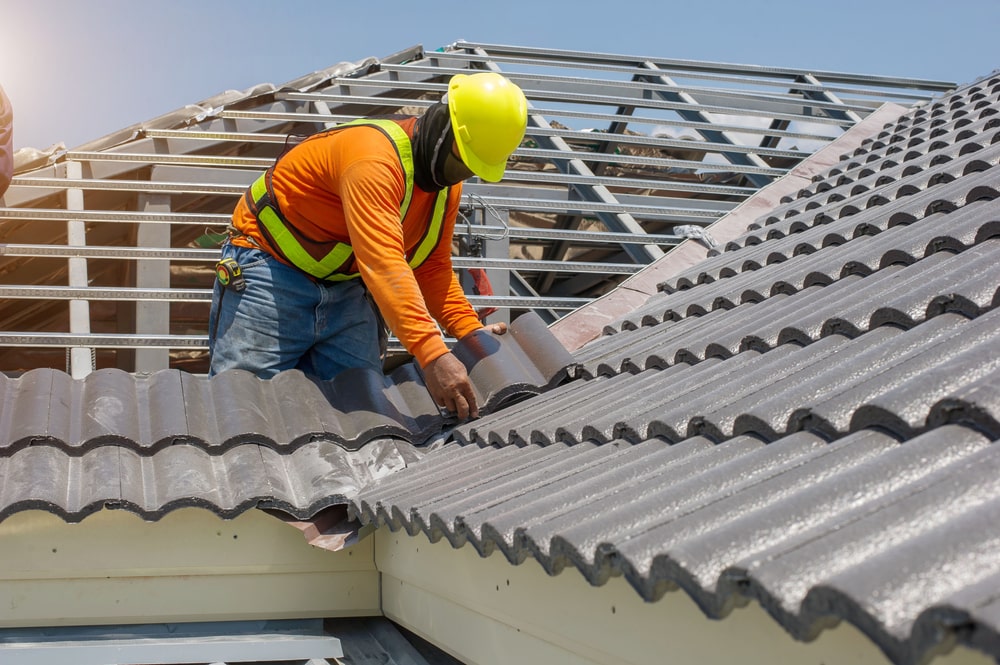The Benefits of Collaborating With Gainesville FL Roofing Companies
Wiki Article
Finest Practices for Ensuring Appropriate Roof Covering Air Flow
A well balanced intake and exhaust vent proportion, typically 1:300, plays a pivotal duty, with intake vents ideally put at the reduced edge of the roof for awesome air access and exhaust vents at the optimal for cozy air exit. Keeping insulation away from vents is critical to stop airflow limitation.Understand Ventilation Basics
Effectively understanding air flow fundamentals is essential for ensuring the longevity and effectiveness of roofing systems. Efficient ventilation mitigates moisture build-up and temperature extremes in the attic, both of which can result in considerable architectural damage gradually. A well-ventilated roof covering assists in avoiding typical issues such as mold and mildew growth, timber rot, and ice dams, which can jeopardize the stability of the roofing materials and the underlying structures.The main objective of air flow is to assist in the activity of air, enabling a consistent exchange in between the indoor and exterior settings. This balance is achieved through a combination of consumption and exhaust vents that work with each other to keep ideal air movement. Consumption vents, usually situated along the soffits or eaves, permit fresh air to get in the attic room room, while exhaust vents, commonly located at or near the roof ridge, enable warm, moist air to escape.
Secret factors affecting the performance of roof ventilation include appropriate placement, sufficient sizing, and guaranteeing that both intake and exhaust vents are unhampered. Normal assessment and upkeep are essential to recognize prospective clogs, damage, or ineffectiveness in the ventilation system, therefore protecting the roofing system's efficiency and resilience.
Types of Roofing System Vents
Roofing vents play a critical function in keeping effective attic air flow and, by extension, the overall health and wellness of the roof system. Various types of roof vents are readily available, each with special benefits tailored to certain roof covering requirements. Ridge vents, for instance, are mounted along the roofing's peak, allowing warm, damp air to get away from the attic room. They provide continual air flow and blend perfectly with the roofline, making them both efficient and aesthetically pleasing.
Soffit vents are set up under the eaves and operate in tandem with roofing system vents to make certain a balanced intake and exhaust system. By allowing cooler air to enter from below, soffit vents assist in the expulsion of hot air via upper vents. Gable vents, located on the outside walls of the attic, deal an additional efficient solution, especially in homes with gable roofs.
Analyze Your Present Ventilation

Next, take into consideration the age and problem of your roof covering products and air flow parts. Older systems might not adhere to present building regulations or may have weakened in time, minimizing their performance. Conduct a detailed evaluation to recognize any type of signs of damage, such as corrosion, damage, or spaces that might endanger the system's performance.
Furthermore, measure the attic temperature level and humidity degrees. High temperature levels and humidity can show insufficient ventilation.
Setup Best Practices
Reliable setup of roof air flow systems is vital for ensuring ideal performance and long life. Appropriate installation begins with understanding the specific air flow requirements of the roof and the building it covers. This includes calculating the right ratio of consumption to tire vents, usually adhering to the 1:300 regulation, which stipulates one square foot of air flow for every 300 square feet of attic floor space.
The positioning of vents is equally important. Intake vents ought to be mounted at the roofing's reduced edge, frequently in the soffits, to permit trendy air to get in. Exhaust vents, on the other hand, need to be installed near or at the roofing system's peak to promote the exit of warm, moist air. This creates a natural air movement that assists preserve temperature and dampness balance hop over to these guys within the attic room area.
Seal all vent links meticulously to protect against air leaks and prospective water seepage. Usage high-quality products and adhere to supplier standards to ensure sturdiness and efficiency. Additionally, integrating ridge vents with baffles can significantly improve airflow efficiency by avoiding wind-driven rainfall and snow from going into the attic.
Inevitably, specific installation of roofing air flow systems reduces prospective issues such as mold development, ice dams, and architectural damage, ensuring the roofing system's integrity and the structure's total health and wellness.
Normal Upkeep Tips
Uniformity in upkeep methods is basic to ensuring the long-lasting performance of roof ventilation systems. Regular examinations are essential, ideally done biannually-- in the springtime and autumn. During these inspections, make certain that vents are totally free of particles, nests, and other blockages that could restrain airflow. Look for any kind of indications of wetness accumulation or mold and mildew, as these can indicate incorrect air flow or leaks (gainesville fl roofing companies).
Use a soft brush or a vacuum to get rid of dust and debris from intake and exhaust vents. Be mindful not to damage the air vent screens or louvers during the procedure.
Appropriate insulation is just as vital. Make sure that attic room insulation does not obstruct the vents, as this can drastically restrict air flow. If any insulation has moved or worked out, rearrange or replace it to preserve a reliable obstacle.
Last but not least, change any type of harmed or missing out on elements immediately. Damaged vents, cracked tiles, or tatty flashing can all add to poor ventilation and needs to be attended to right away. Regular maintenance guarantees that the roof covering ventilation system functions ideally, consequently extending the life-span of the roof covering itself.
Final Thought
Making certain correct roofing ventilation is extremely important for keeping the effectiveness and sturdiness of a roof. Adherence to the 1:300 consumption and exhaust vent proportion, coupled with the tactical placement of vents, is vital. Normal biannual inspections, debris cleansing, and you could try these out making certain insulation does not obstruct air movement are important techniques. Applying these best techniques will foster a well-ventilated roofing system, thereby reducing potential issues connected to moisture buildup and extreme warm, ultimately extending the roofing system's life expectancy.A well balanced intake and exhaust vent ratio, typically 1:300, plays a pivotal duty, with intake vents ideally put at the lower side of the roofing for amazing air entry and exhaust vents at the peak for warm air leave. Consumption vents, commonly situated along the eaves or soffits, allow fresh air to get in the attic room, while exhaust vents, commonly located at or near the roofing ridge, make it possible for their explanation warm, humid air to get away.
Soffit vents are mounted under the eaves and work in tandem with roof vents to make sure a well balanced consumption and exhaust system. By permitting cooler air to get in from below, soffit vents facilitate the expulsion of warm air with upper vents. Adherence to the 1:300 intake and exhaust air vent ratio, combined with the tactical placement of vents, is necessary.
Report this wiki page